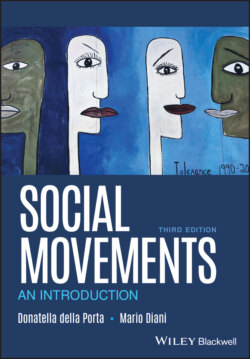Читать книгу Social Movements - Donatella della Porta - Страница 12
1.1.5 Are These Questions Specific to Social Movement Analysis?
ОглавлениеIn this book we shall address these different questions: the social determinants of protest (chapter 2), the role of cultural and symbolic elements (chapters 3–4), the organizational dynamics (chapters 5–6), and the political context for and effects of movements (chapters 7–9). But, before doing that, we still have to discuss whether the questions – and the responses – identified above are peculiar to social movement research. In many cases, these questions address not just social movements but collective action more in general. Collective action broadly refers to individuals, sharing resources in pursuit of collective goods – i.e., goods that cannot be privatized and subtracted to any of the members of the collectivity on behalf of which collective action has taken place. Such goods may be produced within movements, but also in many contexts that normally are not associated with movements. In our notion, the idea of ‘collective goods’ comprises both public goods à la Olson and club goods. For Samuelson (1954), the key characteristics of public goods are non‐excludability, and nonrivalrous consumption (i.e., no scarcity once the good is produced). A club good is nonexcludable for club members but excludable for outsiders, possibly (but not necessarily) non‐rivalrous for those with access (Buchanan 1965).
For example, political parties also face the problem of mobilizing their members and providing them with incentives to join and somehow support the organization – if anything through the payment of membership fees; so do interest groups only minding the sectoral – often, very parochial – interests of their specific reference groups (Jordan and Maloney 1997; Knoke 1990). Likewise, even political parties or narrow interest groups focus face the problem of adapting their strategies and tactics to changing environments, as the context in which they operate may become more or less favorable, such as through changes in the attitudes of power holders toward specific parties or interest groups’ demands, changes in legal opportunities for interest representation, or changes in the cultural models with which ordinary people make sense of their political and social world (Panebianco 1988). From a different angle, many voluntary organizations do not identify any social or political opponent to protest against, and their strategies focus entirely on service delivery rather than advocacy, political representation, or challenges to dominant norms or lifestyles. Even these organizations, however, still face problems of attracting and keeping members, securing the resources necessary to promote action, elaborate the cultural models necessary to pursue goals along the desired lines, and framing their issues in order to make them as attractive as possible to the widest audience as possible (Wilson 2000).
As it happens, analyses of social movements and analyses of collective action at large are inextricably linked. Let us say that the experience of social movements reflects phenomena with more than passing analogies to other instance or political or cultural collective action, taking place within political parties, interest groups, or religious sects. Therefore, when we analyze social movements, we deal with social processes that may also be of interest to researchers who do not define themselves at all as social movement analysts. Accordingly, we feel that a lot of what is presented here may be of interest to a much broader audience.
Recently, there have been several attempts to synthesize scholarship on social movements with the aim of linking it to broader theoretical and/or empirical concerns. Some of these attempts have aimed at integrating social movement theory with general sociological frameworks.
A most ambitious development by social movement scholars, openly criticizing the insularity of the social movements studies community, and also drawing heavily on non‐Western materials, has been the Dynamics of Contention (DOC) program (McAdam et al. 2001). The main suggestion coming from this approach has been the possibility to combine the knowledge developed in the fields of social movements with those elaborated on revolutions, democratization, and ethnic conflicts, singling out a field of contentious politics, defined as “episodic, public, collective interaction among makers of claim and their objects when (a) at least one government is a claimant, an object of claims, or a party to the claim and (b) the claims would, if realized, affect the interest of at least one of the claimants” (McAdam, Tarrow, and Tilly 2001, p. 5). As Sidney Tarrow (2015, p. 90) summarized, the contentious politics approach focused on episodes of contention, rather than on individual social movements, looking at the relations of different actors within complex political processes. Advocating a dynamic rather than static use of concepts, the scholars involved in this project have tried to single out general mechanisms of contention, defined as “delimited changes that alter relations among specified sets of elements in identical or closely similar ways over a variety of situations” (McAdam, Tarrow, and Tilly 2001, pp. 24–25). While criticized for the uncertain status of the concept of causal mechanism as well as for the lack of capacity to account for causes and effects of social movements, the contentious politics approach has rightly pointed at the importance to bridge the field of social movements to other cognate fields (see Diani et al. 2003; Tarrow 2015 for discussions of the approach).
